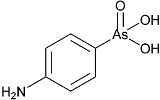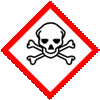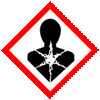4-Aminophenyl Arsonic Acid or Arsanilic Acid BP USP NF FCC Food Grade Manufacturers, with SDS GHS MSDS Sheet |
Supplier, Manufacturer, Exporter of Arsanilic Acid or 4-Aminophenyl Arsonic Acid, Muby Chemicals of Mubychem Group, established in 1976, is the original manufacturers of Specialty Chemicals, Pharmaceutical Excipient, Fragrance Food & Flavor chemicals, Reagent Grade Chemicals, Shale Gas Fracturing Chemicals in India. Mubychem Group has several manufacturing facilities spread across Western India and world wide contacts and toll manufacturers. We are exporting globally to countries like USA, Canada, Europe, UAE, South Africa, Tanzania, Kenya, Egypt, Nigeria, Cameroon, Uganda, Turkey, Mexico, Brazil, Chile, Argentina, Dubai, Korea, Vietnam, Thailand, Malaysia, Indonesia, Australia, China, Germany, France, Italy, Portugal, Bangladesh, etc. The products are offered as per required specifications and in correct shape and size in mm or meshs or microns as specified by the buyer. The participating units have one or more accreditations like FDA - cGMP and GLP approval, ISO-9001 Certified, "REACH" Registered, ISO-14001, ISO/IEC 17025, ISO-22000, FSSC 22000, ISO 45001, Kosher Certified, Halal Certified, HACCP, FSSAI. We offer Commercial Pure & IP BP EP Ph Eur USP NF JP FCC Food Grade Analytical Reagent Grades of Chemicals |
| Bookmark this Web Site -- or -- Email This Page Info to a Colleague or Yourself |
Search our website here:







4-Aminophenyl Arsonic Acid or Arsanilic Acid: CAS Number: 98-50-0, EINECS EC Number: 202-674-3, Molecular Formula: C6H8AsNO3, Molecular Weight: 217.05, HS Code ---**
How big is your requirement or how small
We serve it all.
Specifications, Safety Data Sheet, Manufacturing process details, Wholesale retail prices, Uses etc available on these pages for 4-Aminophenyl Arsonic Acid or Arsanilic Acid.
For SDS MSDS Sheet Click
SDS MSDS Sheet of 4-Aminophenyl Arsonic Acid or Arsanilic Acid Manufacturers
Arsanilic Acid
4-Aminophenyl Arsonic Acid Pure n USP Suppliers

Arsanilic Acid USP Grade
C6H8AsNO3 --- 217.05
p-Aminobenzenearsonic acid [98-50-0].
Arsanilic Acid contains not less than 98.0 percent and not more than 102.0 percent of C6H8AsNO3, calculated on the dried basis.
Labeling: Label it to indicate that it is for veterinary use only.
Identification: Infrared Absorption 197K .
Loss on drying: Dry it in vacuum at 80C for 4 hours: it loses not more than 0.5% of its weight.
Limit of o-arsanilic acid: To pass the chromatographic test: not more than 0.12% is found.
Limit of aniline: pass the chromatographic test: not more than 0.045% is found.
Assay: Transfer about 125 mg of Arsanilic Acid, accurately weighed, to a 50-mL conical flask, and add 10.0 mL of a mixture of sulfuric acid, nitric acid, and perchloric acid (1000:50:50) and several glass beads. Digest on a hot plate for about 1 hour, increasing the temperature of the hot plate in steps until a ring of sulfuric acid rises into the neck of the flask. Allow to cool, to the colorless solution add about 400 mg of hydrazine sulfate, and heat the flask vigorously on a hot plate until a ring of sulfuric acid rises into the neck of the flask. Allow to cool, and wash down the rim, neck, and insides of the flask with about 1 mL of water. Heat the flask again until a ring of sulfuric acid rises into the neck of the flask. Allow to cool, and transfer the colorless solution, with the aid of about 80 mL of water, to a 125-mL conical flask. Add 10 mL of hydrochloric acid and several drops of 0.002 M potassium iodide, cool to between 0C and 5C and titrate with 0.1 N potassium permanganate to a pale pink endpoint, maintaining the temperature between 0C and 5C during the titration. Perform a blank determination and make any necessary correction. Each mL of 0.1 N potassium permanganate is equivalent to 10.852 mg of C6H8AsNO3.
For Original Monographs of IP Indian Pharmacopoeia BP British Pharmacopoeia USP US Pharmacopoeia FCC Food Grade product, please check with the respective web-pages or books.
We also manufacture and supply as under:
Manufacturers:
MUBY CHEMICALS
Ambernath Mumbai, Ankleshwar Gujarat, India
TEL: (OFFICE) +912223770100, +912223726950
Current Date Time in India GMT+5:30
e-mail: info@mubychem.com
USA, Canada, Mexico and other American
neighbouring buyers may
e-mail: us@mubychem.com
Call toll-free 1-877-682-9243 (1-877-MUBYCHEM)

Copyright and Usual Disclaimer is Applicable.
Last :
6 April, 2024




Exporters to USA Canada UAE Europe South Africa Tanzania Kenya Uganda Egypt Nigeria Turkey Mexico Brazil Argentina Chile Dubai etc.
Global or International Suppliers, Exporters, Importers, Manufacturers
I shall pass through this world, but once. If therefore, there is any good that I can do, or if there is any favor that I can show to a fellow human being, let me do it now. Let me not defer or neglect it. For I shall not tread this way again
Arsanilic Acid SDS, Safety Data Sheet
MSDS Sheet, Material Safety Data Sheet 02-Oct-20
1. Product Identification
Product Name & Other Names: Arsanilic Acid 4-Aminobenzenearsonic acid, 4-Aminophenylarsonic acid, 4-Arsanilic acid.
CAS No.: 98-50-0
EINECS: EC Number: 202-674-3
Molecular Weight: 217.05
Chemical Formula: C6H8AsNO3
Relevant uses and uses advised against (if any): Industrial use only.
Supplier: As per letterhead.
2. Hazards Identification
GHS, Globally Harmonized System Classification in accordance with 29 CFR 1910
Classification according to Regulation (EC) No 1272/2008
Acute toxicity, Oral: Category 3
Serious eye damage/eye irritation Category 2B
Acute toxicity, Inhalation: Category 3
Acute aquatic toxicity: Category 3
Labeling according Regulation (EC) No 1272/2008
GHS Label Elements  Toxic |
GHS Label Elements |
Signal Words: Danger
Hazard Statements:
H301: Toxic if swallowed.
H320: Causes eye irritation.
H331: Toxic if inhaled.
H402: Harmful to aquatic life.
Hazards not otherwise classified (HNOC):
May causes mild skin irritation
May cause mild respiratory irritation.
Precautionary Statements:
P301+P310: IF SWALLOWED: Immediately call a POSION CENTER or doctor/physician.
P273: Avoid release to the environment.
P260: Do not breathe dust/fume/gas/mist/vapors/spray.
P262: Do not get in eyes, on skin, or on clothing.
P271: Use only outdoors or in a well-ventilated area.
P264: Wash contaminated parts thoroughly after handling.
P270: Do not eat, drink or smoke when using this product.
P271: Use only outdoors or in a well-ventilated area.
P:273: Avoid release to the environment.
P280: Wear protective gloves/protective clothing/eye protection/face protection.
P312: Call a POISON CENTER or doctor/physician if you feel unwell.
P314: Get medical advice/attention if you feel unwell.
P302+352: IF ON SKIN: Wash with plenty of soap and water.
P304+P340: IF INHALED: Remove victim to fresh air and keep at rest in a position comfortable for breathing.
P305+351+338: IF IN EYES: Rinse cautiously with water for several minutes. P337+P313: If eye irritation persists get medical advice/attention.
Remove contact lenses if present and easy to do – continue rinsing.
P330: Rinse mouth.
P360: Rinse immediately contaminated clothing and skin with plenty of water before removing clothes.
P403+P404: Store in well-ventilated place. Keep container tightly closed.
P405: Store locked up.
P501: Dispose of contents/container in accordance with local/national regulation.
Classification according to EU Directives 67/548/EEC or 1999/45/EC:
Hazard Symbol:
T Toxic
Xi Irritant.
Risk Phrases:
R 23 Toxic by inhalation.
R 25 Toxic if swallowed.
R36 Irritating to eyes.
3. Composition/Information on Ingredients
Product Name & Other Names: Arsanilic Acid 4-Aminobenzenearsonic acid, 4-Aminophenylarsonic acid, 4-Arsanilic acid.
CAS No.: 98-50-0
EINECS: EC Number: 202-674-3
4. First Aid Measures
Always seek medical attention after first aid measures are provided.
Inhalation: Remove to fresh air. If not breathing, give artificial respiration. If breathing is difficult, give oxygen. Get medical attention.
Ingestion: Never give anything by mouth to an unconscious person. Get medical attention.
Skin Contact: Wipe off excess material from skin then immediately flush skin with plenty of water for at least 15 minutes. Remove contaminated clothing and shoes. Get medical attention. Wash clothing before reuse. Thoroughly clean shoes before reuse.
Eye Contact: Immediately flush eyes with plenty of water for at least 15 minutes, lifting lower and upper eyelids occasionally. Get medical attention immediately.
5. Fire Fighting Measures
Auto-Ignition Temperature: Not applicable.
Products of Combustion: Nitrogen oxides (NOx) Carbon monoxide (CO) Carbon dioxide (CO2) arsenic oxides.
Fire: It is not considered to be a fire hazard.
Fire Extinguishing Media: Use water spray, alcohol-resistant foam, dry chemical or carbon dioxide. Use means suitable for extinguishing surrounding fire.
Special Information: In the event of a fire, wear full protective clothing and NIOSH-approved self-contained breathing apparatus with full face piece operated in the pressure demand or other positive pressure mode. At high temperatures or when moistened under fire conditions, it may produce toxic or irritating fumes.
6. Accidental Release Measures
Personal precautions, protective equipment, and emergency procedures: Ventilate area of leak or spill. Avoid breathing dust/fumes/gas/mist/vapors/spray. Use individual protective equipment (waterproof boots, suitable protective clothing, safety glasses, etc.). Restrict unprotected personnel from the area. Prevent any contact with hot surfaces. Do not approach facing the wind. Do not touch the spilled material.
Environmental precautions: Do not let the product enter drains, soil, or water sources.
Methods and materials used for containment Cleanup procedures and Storage:
Small Spill: Avoid dust formation. Avoid breathing dust/mist/vapors. Ensure adequate ventilation. Use appropriate tools to put the spilled solid in a convenient waste disposal container. Finish cleaning by spreading water on the contaminated surface and dispose of according to local and regional authority requirements.
Large Spill: It is a poisonous solid. Avoid touching the spilled material. Contain spilled material. Cover with an inert, non-combustible absorbent material, (e.g. sand, earth, diatomaceous earth, vermiculite). Vacuum or sweep-up and remove to an approved disposal container.
7. Handling and Storage
Toxic! Do not ingest. Do not breathe dust. Wear suitable protective clothing. In case of insufficient ventilation, wear suitable respiratory equipment.
Precautions for safe handling: Apply according to good manufacturing and industrial hygiene practices. Ensure proper ventilation. In case of insufficient ventilation, wear suitable respiratory equipment. Wash thoroughly after handling. Do not drink, eat, or smoke while handling. Avoid contact with skin, eyes, and clothing. Minimize dust generation. Avoid breathing dust/fumes/gas/mist/vapors/spray. Avoid contact with eyes, skin, and clothing. Keep container tightly closed. Avoid ingestion and inhalation. Use individual protective equipment (waterproof boots, suitable protective clothing, safety glasses, etc.). Prevent any contact with hot surfaces.
Conditions for safe storage, including any incompatibilities: Store in cool, dry, and ventilated area away from heat sources and protected from sunlight in tightly closed original container. Keep air contact to a minimum. Store protected from heat, sparks and ignition sources and incompatible materials. Avoid contact with skin and eyes. Avoid inhalation of dust/mist/vapor. Do not store with incompatible materials like strong oxidizing agents and acids.
8. Exposure Controls/Personal Protection
Airborne Exposure Limits: Permissible Exposure Limit Ontario TWAEV: TWA: 0.01 mg/m3, STEL: 0.05 mg/m3
Ventilation System: A system of local and/or general exhaust is recommended to keep employee exposures as low as possible. Local exhaust ventilation is generally preferred because it can control the emissions of the contaminant at its source, preventing dispersion of it into the general work area.
Personal Respirators (NIOSH Approved): For conditions of use where exposure to dust or mist is apparent and engineering controls are not feasible, a particulate respirator may be worn. For emergencies or instances where the exposure levels are not known, use a full-face positive-pressure, air-supplied respirator.
Skin Protection: Wear protective gloves and clean body-covering clothing.
Eye Protection: Use chemical safety goggles and/or full face shield where dusting or splashing of solutions is possible. Maintain eye wash fountain and quick-drench facilities in work area.
Other Control Measures: Maintain good housekeeping in work area. Dust deposits on floors and other surfaces may pick up moisture and cause the surfaces to become slippery and present safety hazards. Handle in accordance with good industrial hygiene and safety practice. Wash hands after handling.
9. Physical and Chemical Properties
Appearance: Off-white powder.
Odor: It is practically odorless.
Odor threshold: Not available.
pH: Not available.
Relative density: around 1.96
Melting Point: 230-233C.
Initial boiling point and boiling range: Not available.
Flash point: Not available.
Auto-ignition temperature: Not available.
Decomposition temperature: Not available.
Upper/lower flammability or explosive limits: Not available.
Vapor pressure: Not available.
Vapor density: Not available.
Evaporation rate: Not available.
Flammability (solid, gas): Not available.
Partition coefficient: n-octanol/water: Not available.
Solubility: Very slightly soluble in water.
Viscosity: Not available.
Molecular Weight: 217.05
Chemical Formula: C6H8AsNO3
10. Stability and Reactivity
Stability: Stable under ordinary conditions of use and storage.
Hazardous Decomposition Products: Nitrogen oxides (NOx) Carbon monoxide (CO) Carbon dioxide (CO2) arsenic oxides.
Hazardous Polymerization: Will not occur.
Incompatibilities: Strong oxidizing agent and acids.
Conditions to Avoid: Incompatibles and heat.
11. Toxicological Information
Acute toxicity
Toxic, and may be fatal, if swallowed. Chronic exposure may cause damage to a variety of body organs. Harmful if inhaled. Typical TLV/TWA 0.5 mg m-3.
Toxicity data
Oral, rat: LD50 = >1 gm/kg
Carcinogenic Effects: IARC: Group 1 carcinogen
Mutagenic Effects: Not available.
Teratogenic Effects: Not available.
Developmental Toxicity: Not available.
Other: The hazards associated with arsenic may be seen in this product.
12. Ecological Information
Toxicity to fish: NA
Environmental Toxicity: Harmful to aquatic organisms.
Persistence and Degradability: No information available.
Mobility: No information available.
Bioaccumulation/ Accumulation: No information available.
Results of PBT and vPvB assessment: No data available for assessment.
13. Disposal Considerations
Whatever cannot be saved for recovery or recycling should be managed in an appropriate and approved waste disposal facility. Processing use or contamination of this product may change the waste management options. State and local disposal regulations may differ from federal disposal regulations. Dispose of container and unused contents in accordance with federal, state, and local requirements.
14. Transport Information
DOT USA, ADR/RID Europe, IMDG & Canada TDG Classification:
UN-Number: 3465
CLASS 6.1
Packing group: III
Identification: ORGANOARSENIC COMPOUND, SOLID, N.O.S.
IATA
UN number: UN3077
UN proper shipping name: Environmentally hazardous substance, solid, n.o.s. (p-Arsanilic acid)
Class 9
Packing group III
Environmental hazards No.
15. Regulatory Information
USA:
SARA 302 Components: No chemicals in this material are subject to the reporting requirements of SARA Title III, Section 302.
SARA 313 Components: This material is subject to the reporting requirements of Section 313 of SARA Title III and 40 CFR Part 373.
SARA 311/312 Hazards: Acute Health Hazard. Chronic Health Hazard.
Section 16 - Additional Information
European Labeling in Accordance with EC Directives:
H301: Toxic if swallowed.
H320: Causes eye irritation.
H331: Toxic if inhaled.
H402: Harmful to aquatic life.
Classification according to EU Directives 67/548/EEC or 1999/45/EC:
Hazard Symbol:
T Toxic
Xi Irritant.
Risk Phrases:
R 23 Toxic by inhalation.
R 25 Toxic if swallowed.
R36 Irritating to eyes.
Disclaimer:
****************************
Our company provides this MSDS sheet in good faith but makes no representation as to its comprehensiveness or accuracy. This SDS sheet is intended only as a guide to the appropriate precautionary handling of the material by a properly trained person using this product. The above information has been compiled from various sources and has the possibility of discrepancy and being out-dated information. Individuals receiving the information must exercise their independent judgment and do further search in determining its appropriateness for a particular purpose. In no case shall our company be liable to loss or damages by the product user.
****************************
















